TPO -> USA RPOs
USA RPOs
By Frank R. Scheer
Start and finish dates: June 1864 to 30th June 1977.
An interesting facet of RPO history is the legacy of postmarked covers. A "cover" is a stamped, addressed envelope that moved through a postal system from writer to recipient. These are tangible, collectible mementoes of the USA passenger train network.
A postmark is applied where a mail piece enters the postal system. For this reason, RPO markings are less common than city/town postmarks.
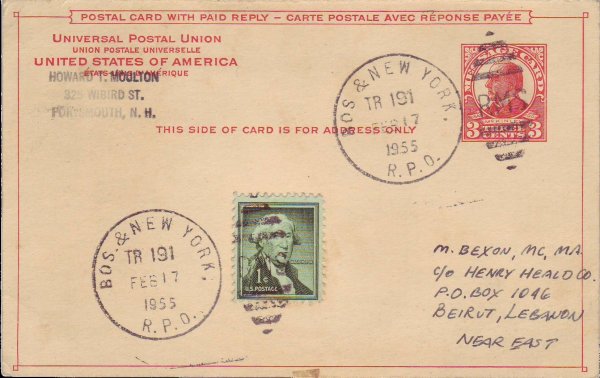
When the RPO network was viable, that is, generally prior to 1958 - a majority of intercity First Class, newspaper, and periodical (Second and Third Classes) mail was distributed aboard Railway and Highway Post Offices. This also includes RMS/PTS Terminals during mail overflow situations, such April 15 (tax day) or during December. Perhaps 98% of non metropolitan area mail was carried by RPOs.
Even though the vast majority of envelopes one might find today with city and town postmarks don't show RPO markings, one or more RPO or HPO clerks likely handled it if it travelled more than 25 miles. The inverse seems to be true: perhaps one percent or less of all covers bore a RPO marking.
When a letter entered the mail stream at a RPO, it started its journey that way for three reasons. One was that it was deposited into the car (railway carriage) via a public letter slot on the side of a RPO car, or handed it to the clerk in the RPOs doorway during a station stop. Another occurrence was when a letter box was erected on a station platform; a clerk from the RPO would "rob the box" during a station stop. The last approach was prevalent as RPOs were being discontinued. This was to mail self addressed stamped envelopes in an outer envelope addressed to "Clerk in Charge / ----&----RPO / Origin City and State." Collectors seeking last run covers typically used this approach for obtaining philatelic use covers when they could not travel to those cities to personally mail the covers aboard the RPO.
When mail was sorted on board, if a piece had been missed by the office of origin, the clerk might hand stamp a postmark on the overlooked piece, mail was also picked up from mail cranes in designated towns when the train was on the move.
The RPO postmark was not applied to un-cancelled covers discovered during distribution. It was the responsibility of the delivery office to obliterate the stamps. The rationale is that someone could mistakenly believe that a mail piece entered the mail stream at the point shown in the postmark, not at its actual origin. The same principle applied to mail dispatched to the train in a catcher pouch. That mail was all postmarked at its originating office, not on board the RPO.
Although RPOs distributed First, Second, and Third Class mail (plus some Fourth Class parcel post if "Special Handling" fee was paid for this service), postal regulations limited mailings aboard a RPO to fully paid First Class items. RPO postmarks are not seen on these other classes because they couldn't enter the mail stream aboard a RPO.
RPO postmarks were also applied to mail pieces in two other situations. One is as a back-stamp on Special Delivery matter. This was done to allow reconstruction of its handling if there was a delay en route. The other is to annotate a missent letter. "Missent" means that a mail piece was despatched incorrectly from one unit to another. Since the item was out of route and subjected to delay, the RPO where the error was detected postmarked the item and added an auxiliary marking, "MISSENT".
A steel postmarker assigned to the Clerk-in-Charge was ordinarily the one used to postmark mail within a RPO. However, Railway Postal Clerks (RPCs) were required to have a "personal postmark" device. Usually a rubber stamp, it showed their name, work assignment location, train/trip/tour (abbreviated "TR") number, and date. Imprints were made upon facing slips, pouch/sack labels, and official correspondence.
On occasion, these markings may also appear on the rear of special delivery or registered mail envelopes, indicating that the clerk performed distribution of that mail piece. Rubber stamps after the mid 1950s were provided by the Post Office Department by requisition. Prior to that era clerks procured or made their own personal postmarkers, but at their own expense. Those often continued in use for as long as the clerk worked on that route.
A sample postmark appears below. RPO markings during the 1900s are generally similar to this example.
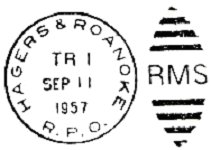 The route name (often abbreviated in this example for the Hagerstown, Maryland, and Roanoke, Virginia,
RPO) is arranged with the northern or eastern terminal is listed first. Unlike British TPO markings,
the same handstamp was used for trips in both directions, designated by the train number (in this
case, train 1). The letters R.P.O. at the bottom designates the type of mobile unit. Finally, the
"RMS" between the killer bars - the horizontal lines used to cancel the stamp(s) on a mail piece -
is the abbreviation for the Railway Mail Service. Many postmarkers continued in use after the
change to the Postal Transportation Service (PTS) that became effective on October 1, 1949.
The route name (often abbreviated in this example for the Hagerstown, Maryland, and Roanoke, Virginia,
RPO) is arranged with the northern or eastern terminal is listed first. Unlike British TPO markings,
the same handstamp was used for trips in both directions, designated by the train number (in this
case, train 1). The letters R.P.O. at the bottom designates the type of mobile unit. Finally, the
"RMS" between the killer bars - the horizontal lines used to cancel the stamp(s) on a mail piece -
is the abbreviation for the Railway Mail Service. Many postmarkers continued in use after the
change to the Postal Transportation Service (PTS) that became effective on October 1, 1949.
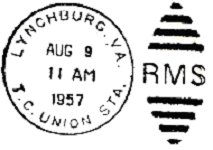 Several similar markings resemble those of RPOs and are equally collectible. The adjacent postmark is
from the Transfer Clerk (TC) at the Union Station, Lynchburg, Virginia. Transfer Clerks supervised
mail connections between RPOs at junctions and worked at a Transfer Office (TO).
Several similar markings resemble those of RPOs and are equally collectible. The adjacent postmark is
from the Transfer Clerk (TC) at the Union Station, Lynchburg, Virginia. Transfer Clerks supervised
mail connections between RPOs at junctions and worked at a Transfer Office (TO).
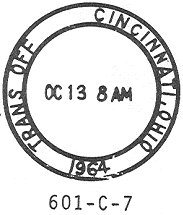 An alternate postmark design is this double-ring marking from Cincinnati. It was produced by a
barrel-style postmarker that is similar to European designs. There are date wheels that are rotated
to correct settings and locked in place with a pin. Incidentally, the gap between "Trans(fer)
Off(ice)" and "Cincinnati" likely included the letters "P.T.S." The PTS was abolished in 1960 and
replaced by the Bureau of Transportation. The "601-C-7" under the illustration refers to the
United States Transit Markings Catalogue entry, published by the Mobile Post Office Society.
An alternate postmark design is this double-ring marking from Cincinnati. It was produced by a
barrel-style postmarker that is similar to European designs. There are date wheels that are rotated
to correct settings and locked in place with a pin. Incidentally, the gap between "Trans(fer)
Off(ice)" and "Cincinnati" likely included the letters "P.T.S." The PTS was abolished in 1960 and
replaced by the Bureau of Transportation. The "601-C-7" under the illustration refers to the
United States Transit Markings Catalogue entry, published by the Mobile Post Office Society.
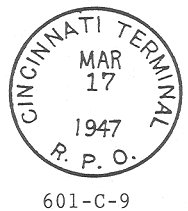 A Terminal (TERM) - referred to as a Terminal Railway Post Office prior to the 1950s - was a
stationary mail processing facility. It often adjoined a railway station in principal USA cities.
This marking was produced by a rubber handstamp. Terminals were seldom locations for first class
mail acceptance, so a TERM marking is uncommon. The postmark design may also look similar to
those of the RPO and TC/TO markings already illustrated.
A Terminal (TERM) - referred to as a Terminal Railway Post Office prior to the 1950s - was a
stationary mail processing facility. It often adjoined a railway station in principal USA cities.
This marking was produced by a rubber handstamp. Terminals were seldom locations for first class
mail acceptance, so a TERM marking is uncommon. The postmark design may also look similar to
those of the RPO and TC/TO markings already illustrated.
 Few RPO, TO/TC, or TERM operations used cancelling machines. This is an example of one.
Few RPO, TO/TC, or TERM operations used cancelling machines. This is an example of one.
Markings rarity is beyond the scope of this brief discussion. Publications available from the USA's Mobile Post Office Society can provide additional information about routes.
Resources:
US Railroad Contract Mails, the First Four Decades by Hugh Feldman, UK.
The US Postal Bulletins: The Digitized U.S. Postal Bulletin provides a fully searchable digitization of the U.S. Postal Bulletin from 1880 to 1971. You may submit simple or complex inquiries, including “full text” searches, as every word in each issue has been OCRed. Relevant examples of searches: RPO Service Changes, RPO Services Established, RPO Through Registered Pouches, Railroad Services Changed, Railroad Service Established, Railroad Service Established-Discontinued-Changed, Electric Car Services Established, Changes in Star Schedules, Electric Car Service Changes, Mail Messenger Services Established, Mail Messenger Services Changed, Mail Messenger Services Discontinued.
Frank R. Scheer is The Secretary and treasurer of the Railway Mail Service Library Foundation located in Boyce, Virginia USA. He has provided many articles for The Journal as well as other papers, now available here, for downloading.

